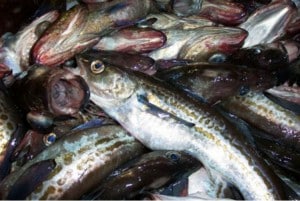
To be labeled “Alaska pollock” the versatile flavored white fish, employed by chefs in everything from seafood salads to fish sticks and filets, must now be harvested from Alaska waters.
Otherwise, says the US Food and Drug Administration, it is simply “pollock.”
The FDA updated its Seafood List on Jan. 21 to reflect that change, recognizing a mandate by Congress in the fiscal year 2016 Omnibus Appropriations that only Pollock caught in Alaskan waters or the exclusive economic zone, (as defined in Section 3 of the Magnuson-Stevens Fishery Conservation Management Act,) adjacent to Alaska can be called Alaskan Pollock.
The change, effective immediately, was hailed by harvesters and processors of Alaska pollock, who said they hope the new labeling will help consumers to choose Alaska sourced pollock products over competing Russian Pollock.
Alaska pollock, also known as walleye pollock, is the largest by volume wild fishery in the United States, and one of the largest fisheries in the world.
Processors of Alaska pollock estimate the industry’s annual value at more than $700 million, with direct employment of some 5,000 workers.
“We are the gold standard for sustainability,” said Pat Shanahan, program director for the Association of Genuine Alaska Pollock Producers.
“It was the right thing to do for consumers and processors,” she said. “It’s accurate. It corrects a problem that has existed for a very long time. We think it will be very useful because (now) we can differentiate.”
Jim Gilmore, speaking for the At-Sea Processors Association, said they are appreciative of the work of the Washington State and Alaska congressional delegations in getting the name change approved by the FDA.
Sen. Lisa Murkowski, R-Alaska, who has worked to change the market name of pollock, said she was “thrilled that this change has been made to protect both our fisheries and consumers.
“It is disingenuous and harmful to our fishing industry for Russian-harvested pollock to be passed off as Alaskan,” she said.”
Gilmore agreed.
“We think it is confusing to a consumer trying to figure out the providence of their seafood, if they can call Russian Pollock Alaska Pollock,” he said.
“It is a question of a very different processing method. When fish comes out of Alaska it is frozen once before it comes out on a consumer’s plate,” Gilmore said, the Russian fish is frozen in the round when it comes on to their vessels, then refrozen in China after it is filleted.
“The vast majority of Russian produce is twice frozen,” Shanahan said. “Just the twice freezing process will have inferior texture, taste and aroma. I have looked at them side by side and I don’t think you have to be an expert to tell the difference,” she said.
Fishermen’s News Online grants permission to the Alaska Native News to post selected articles. Read More at: Fishermen’s News Online.
[xyz-ihs snippet=”Adsense-responsive”]

